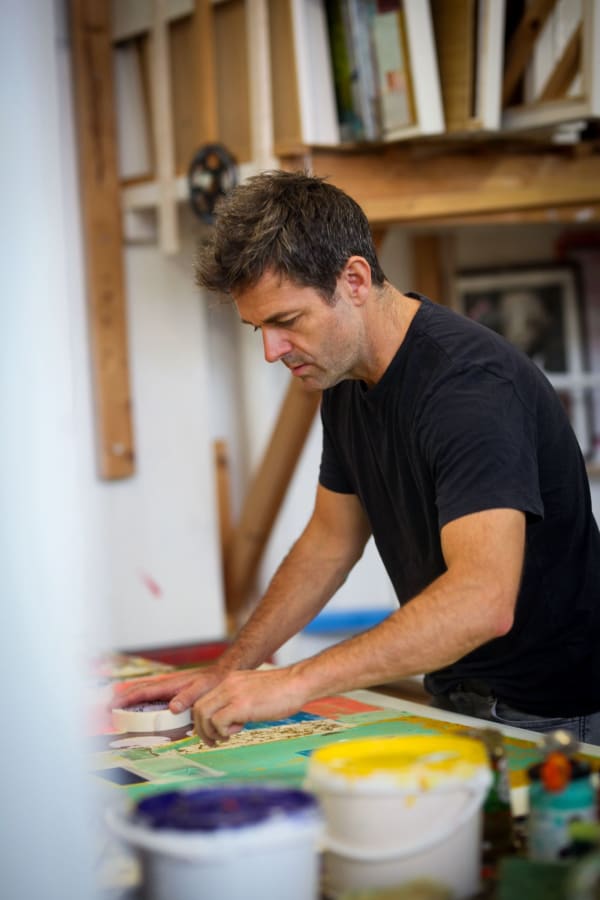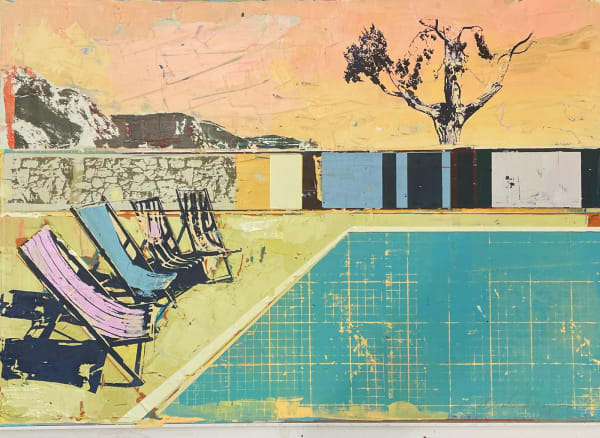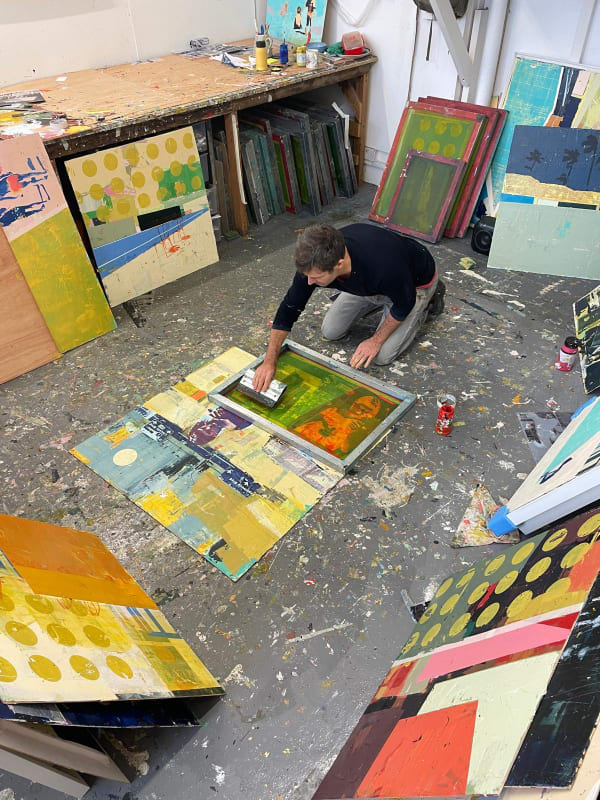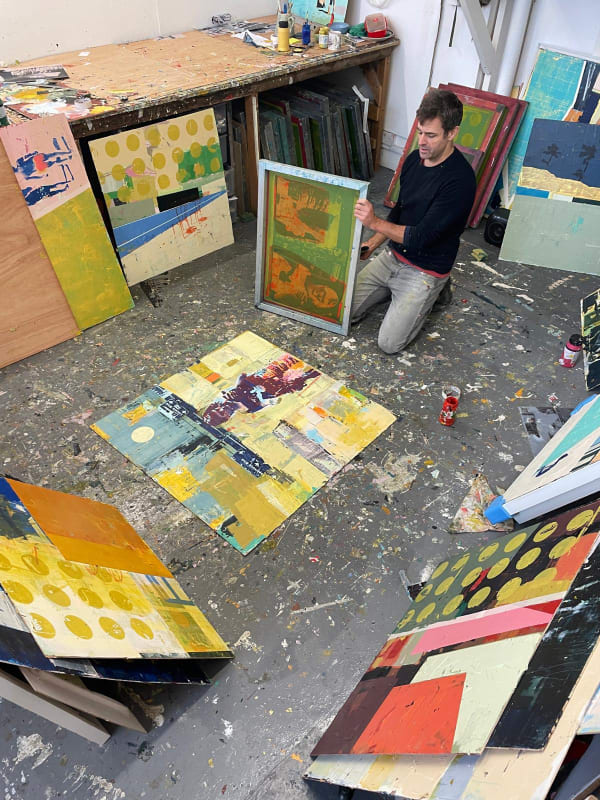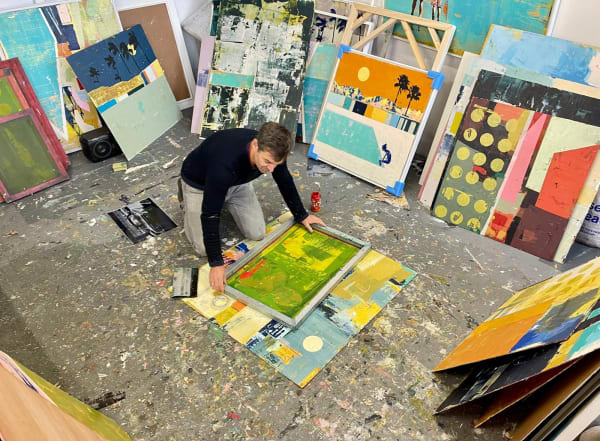I don’t have a desire to communicate anything specific with an audience. I think if I worked with half an eye on what the viewer will think it would constrain my process – having said that... when I am told that a certain piece has affected someone it feels like a real privilege.
– Dan Parry-Jones, 2024
EASTWOOD FINE ART: Having originally trained in Illustration and Graphic Design, has your background informed your approach to your work and subject matter?
DAN PARRY-JONES: It’s an interesting question and hard to know what informs my current process and practice. I guess it’s a combination of everything. Studying graphic design was a way of exploring formal elements like composition, colour etc., which are universal elements fundamental to all branches of visual arts. Answering design briefs and visual problem-solving was a useful practice in terms of how it equipped me to design my future paintings. In terms of subject matter, it is always interesting for me to see how it evolves. I have always been drawn to landscapes but as you say (below) the theme of man-made vs. natural or the scribble juxtaposed with the straight edge is an aesthetic that I seem to return to, especially when I am ‘in the zone’ and working in an automated way; which is the way I begin all my pieces no matter how pre-planned they are.
EFA: Your paintings combine different media and techniques, could you tell us more about how you make your work?
DP-J: Yes, I love photography and I love painting, so I think it was only a matter of time before I started to combine the two in this way. I paint on wooden boards with layers of acrylic, sometimes thickly applied with a palette knife, sometimes thinly, allowing previous layers to partially show through. As the work progresses I will use an electric sander to flatten the areas I want to screenprint onto. This makes the wood smooth and flat but also creates further texture and markings as it does so. After the screenprint, I will apply more paint to these areas, then reprint over the top.
EFA: There is a strong relationship between natural and man-made elements in your landscapes – luminous mountains and trees are often layered against pared-back modernist buildings and pools – what do you want your viewers to experience in your work?
DP-J: I don’t have a desire to communicate anything specific with an audience. I think if I worked with half an eye on what the viewer will think it would constrain my process – having said that, I speak to people regularly at art fairs or visitors to my open studios in Bristol and the comments are so varied – often people connect with the paintings on a very personal level, saying they invoke memories of childhood holidays or places they have lived. When I am told that a certain piece has affected someone like this it feels like a real privilege; it is for me one of the best parts of being an artist.
EFA: Tell us about what inspires your practice, be it your surroundings, music, or the work of other artists for example.
DP-J: I love to travel to new places to inspire me. I have been on biking trips to Southern Spain for example and have found the arid dusty landscape perhaps with the occasional man-made structure appealing visually.
I’m drawn to big advertising hoardings in rocky deserts or swimming pools with an empty Californian backdrop. The theme of man-made together with the natural is not in any way original, my work just seems to have this aesthetic underpinning every painting. In terms of artistic influences, I have always loved the Americans like Diebenkorn, Rauschenberg and Richter for example. More recently I have found and love the work of the New York-based abstract painter Robert Szot.
EFA: For SPOTLIGHT, you are making two new pieces, could you tell us more about them?
DP-J: These two paintings are examples of how I’m exploring the idea of abstraction with photography. As mentioned earlier, I’m drawn to the subject of pools because it allows me to play with the notion of the artificiality of landscape and how we have imposed ourselves on the land. Motorways have always fascinated me in a similar way. I like to use the grid – graph paper exposed onto a silkscreen – to emphasise the artificialness further. It interests me that someone will look at a turquoise rhombus and without thinking talk about ‘the pool’ in the painting despite it not remotely resembling water.
I will have an idea of the composition first and then expose the photographic elements onto the silkscreens. Then using a broad palette knife I will smear patches of colour to map out the composition; water, sky, wall etc. When the first layers of paint are dry I continue to work different colours over the top, I particularly like to apply paint over semi-dry layers beneath. This can create all kinds of accidental marks, most of which will disappear as I keep working. From here on it becomes about scraping paint away, screen printing elements on, painting over the screen prints, printing over the paint, and on until I’m happy with the result. As the paint is so thickly applied I usually work on five or six paintings at once to allow for drying time between layers.
